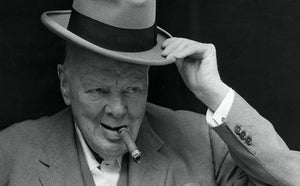“Live your life, do your work, then take your hat.” – Henry David Thoreau, American Poet & Author, 1817-1862
I was in my early 30’s when I was forced into the realization that, like a vintage convertible, I was becoming more appealing with age, and also had a hole in my top. In other words, my hair was thinning. I had never before been a “hat guy” but decided it might be a good idea to start searching for my style. Not out of embarrassment, but because, at the time, I thought I was going bald not just merely thinning, and wanted something to protect my soon to be bare scalp against the elements. Plus, hats are cool and it seemed like a good excuse to get one.
I soon found that there were a number of do’s and don’ts related to hat wearing, and while most are simply tradition at this point, they still convey a gentlemanly understanding of respect and reverence.
Why Does Hatiquette Matter?
The first question many will undoubtedly ask is, “Who cares?” At this point, hats are…well, old hat…and have become such common attire that following rules for the sake of tradition seems kind of dumb. Though it may be tradition, proper hat etiquette signifies a manly attitude of respect and deference for others and places. Do you think people respect the man more who waltzes through life, unaware of his surroundings and inattentive to the presence of a lady or persons of significance, or the one who practices deliberate consideration for times, places, and people?
It’s Tradition
If something is practiced out of tradition does that mean it is not genuine? Of course not. I am reminded of another example of etiquette to make my point. If you drive through any rural part of the country, there is a good chance that someone headed in the opposite direction will wave to you. They don’t know you, they are just being friendly, acknowledging you and bidding “howdy” or “safe travels.” People who are not used to this — those who have lived in the city most of their lives — at first think it fairly odd, but always enjoy the friendly nature conveyed in such gestures. Tradition can still have an impact.
Historical and Universal Sign of Respect and Deference
“A crown is merely a hat that lets the rain fall in.” – Frederick the Great, Prussian King, 1712-1786
There is something about the hat, or crown, which carries an almost instinctual significance. The Greek Olympian victors were crowned with a laurel wreath. Kings, obviously, are crowned. Christ had his crown of thorns, a mocking gesture. And, while halos are not mentioned in the Bible, they have long represented deity and holiness. Throughout history and many cultures, when a person comes before an authority figure or someone of significance, they would remove their head-covering and bow, kneel, or fall prostrate; signs of submission, respect, and recognition of authority. Just as the crown of a king signifies the authority of the monarchy upon him, having no head-covering before the king signifies his authority over his subjects.
It is easy to see how, over time, this has managed to become a gentlemanly way of expressing respect to people and places of worship.
A Quick Guide to Hatiquette
If you don’t want to get into the particulars detailed in the rest of the article, at least know the basics so you don’t look like a rude punk. Here’s a quick guide to the levels of respect conveyed by degrees of hat removal.
No Particular Respect, Consideration, or Acknowledgment — Hat stays on.
Particular Respect or Acknowledgement — Tip of the hat or touch of the hat brim.
Distinguished Respect or Acknowledgement — Hat raise. In this mode the hat comes off the head but just briefly and is placed immediately back on.
Reverential Respect or Acknowledgment — Hat comes off. For example, times of prayer or meeting someone new. The hat may be held and placed back on after the time has passed.
Complete Respect and Acknowledgment — Hat comes off, stays off, and may be placed out of sight. Generally this would be when entering a house of worship or as a guest in someone’s home.
The Rules of Hatiquette
If you have been wearing a hat for some time, you may have been introduced to many of these rules already, though you may not always follow them. It can seem a bit strange to go around tipping your hat to some and raising it to others, but such is the nature and expense of fostering a gentlemanly deportment.
Hat Tip or Raise?
Either the tipping up or down the brim of the hat or fully raising it may be acceptable, but strictly speaking there are times when one or the other should be used.
Tip O’ the Hat to Male Friends
When you come by a male friend on the street or elsewhere hats may be worn, it is customary to greet them with a tip of the hat. Depending on your style, this may be a tipping up or down of the hat, and is simply a way of saying “Hello, good sir” or “Howdy.” A full raise of the hat is also acceptable but not necessary unless you and your pals prefer that formality.

A tip of the hat to a friend is a gentlemanly greeting.
Raise the Hat for a Lady or Particularly Honored Person
When acknowledging a lady it is proper to give a full raise of the hat. The same rule might apply to greeting older men or someone of particular respectability. For instance, a mayor, governor, police officer, local hero, etc.

The hat should be raised when acknowledging a lady or person of significance.
Hats Off
Here are instances when a hat should be removed.
When Meeting Someone for the First Time
Whether it be a man or woman (but especially when it is a woman), remove your hat upon initial introductions. One point of note: don’t run your hands through your hair before shaking hands. Just let your mop alone and get to the shaking of hands and exchanging of names. Once the initial introduction is complete the hat can go back on.

A hat should come off and be held to the side when meeting someone for the first time, especially when it is a lady.

Even when meeting men, out of doors, it is proper hatiquette to remove your hat.
When Talking for an Extended Period of Time
When stopping to talk to someone, man or woman, the hat should be removed. This demonstrates respect and also signals the intention of engaging in a conversation. There are a number of occasions when this rule does not apply, such as when in formal dress or uniform. It also appears that when men are with fellows they know well, this rule does not apply. Use it as you see fit.
When Indoors
The general rule is to remove your hat when coming in the house and place it back on when outside. I especially remember this rule being enforced while in the military. The foldable hat that most branches of the military uses, called a side cap or garrison cap, is easily folded and put in the belt or tucked into the waistline of your pants when not being worn. This is another rule that has a lot of modern leeway. In the past you would remove your hat when you entered a bank or grocery store, but that is no longer the case. It may be quite gentlemanly to do so, but it is also quite inconvenient when you don’t have a place to hang your hat. However, if at work or at someone else’s home, remove the hat.
Note: I followed up on a thought presented by a manly commenter. It appears that banks may require you to remove your hat and sunglasses when you enter, not for the sake of etiquette but so the security cameras can get a clear view of your face.

The side cap or garrison cap as pictured, is removed (uncovered) when indoors and not recovered until outside.
When Eating at the Table
There are a few reasons why a hat should come off when eating. One, if you are inside it should already be off. Two, and most importantly, taking a hat off means you are going to stay a while and enjoy the meal and conversation. Imagine a man and his sons coming in for lunch after a long hard morning of work. The wife has been working hard as well, tending the garden and getting the food ready. How would she feel if they came in, wolfed down their meal and headed back out to work, versus taking off their hats, taking their time to thank her, enjoy the meal, and finally head back out? You can see the message this conveys. Also, depending on the circumstances, a hat can be pretty nasty and it may be best to leave it outside or on the floor.
Note: An exception to this rule may be when eating out of doors, as in a picnic or some potluck get-together. In some instances, nature trumps civility.
When Praying or in a Place of Worship
When engaged in prayer or listening to prayer, or in a place of worship, take the hat off. This is a form of reverential respect. Most of the time this is simply done out of tradition, but some Christians will use 1 Cor. 11 to justify this practice. I have noticed that people will leave their hats on until they get into the actual sanctuary and keep it on in other parts of the church building. However, this violates the “When Indoors” rule.

Take the hat off when praying or when others are praying.
During the Pledge of Allegiance or National Anthem
Thankfully, we still see this being practiced regularly during the opening ceremony for sporting events. Remove your hat and hold it as you listen to or join your countrymen in the National Anthem. Remove your hat and place it over your heart during the Pledge of Allegiance.

Remove your hat during any ceremonial event such as the Pledge of Allegiance or National Anthem.
Final Thoughts
I hope this article helps men who consider a hat a mere fashion accessory. As men don’t do “fashion” and we don’t have accessories (we have tools), a hat can be neither. However, we do occasionally enjoy a rugged style and dapper-enhancing attire to which a cap or hat may compliment.
Now that you know proper hatiquette, what hat are you going to wear?


 “Live your life, do your work, then take your hat.” – Henry David Thoreau, American Poet & Author, 1817-1862
“Live your life, do your work, then take your hat.” – Henry David Thoreau, American Poet & Author, 1817-1862 “A crown is merely a hat that lets the rain fall in.” – Frederick the Great, Prussian King, 1712-1786
“A crown is merely a hat that lets the rain fall in.” – Frederick the Great, Prussian King, 1712-1786